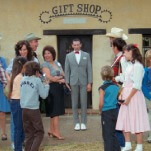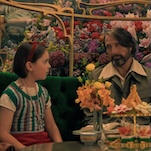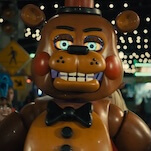It’s A Wonderful Life shows the unending cost of being good
You already know the 12 Days Of Christmas, with its drummers drumming and partridges and gold rings, but we here at The A.V. Club like to take everything one step further, for your reading pleasure. Hence, 13 Days Of Christmas, a collection of essays on a handful of beloved holiday classics and a few that have sadly fallen through the cracks. Up today, It’s A Wonderful Life.
Geneticist George R. Price concluded the way altruism works is like this: We carry DNA that we hold in common with our direct relatives, our less direct relatives, all human beings, all primates, all mammals, and all living things, in descending order of how much we and they have in common. That percentage in common is what drives altruism, our willingness to sacrifice ourselves for the wellbeing of others. Say you see someone trapped in a burning building. If it’s your child, you’ll run in there as quickly as possible, both because that’s what parents are conditioned to do and because that child is a direct continuation of your own genetic line. What if it’s your niece or nephew? Again, you’re very likely to risk everything to save the kid, because of the connection you have. But what if it’s some kid you don’t know? What if it’s a puppy? What if it’s a plant? The further our DNA gets from that which is threatened, the less likely we are to risk everything to save it. The unknown child perpetuates the human race; the puppy perpetuates a fellow mammalian species. But the plant? You’ll let it burn without a second thought.
This thought revolutionized the understanding of psychology, genetics, and the concept of goodness. It made Price’s career. It also ruined his life. “Goodness” is one of those things we like to believe is capable of making humanity more than just a collection of animal impulses. Yet even a quail will sacrifice herself to protect her young, and when we get right down to it, we’re all systems of evolutionary checks and balances. Price, an atheist, had a conversion to a kind of radical Christianity after arriving at his theory of altruism. He started opening his home to the homeless, trying to find that one selfless act that would prove goodness wasn’t as hardwired into us as our own worst impulses. He never succeeded. On January 6, 1975 (the Feast of the Epiphany, the day that marks the traditional end of the Christmas season), Price killed himself in a London squat where he had been living. He had become depressed over the holiday and never broke through his own bleakness to resurface. Price had found a way to express kindness via math, and it became a tragedy that haunted him.
The men who made It’s A Wonderful Life lived with tragedy as an unending specter as well. The film, famously a flop on its initial release, was the first directed by Frank Capra on his return from World War II, and the first to star Jimmy Stewart after he came home from fighting. It’s easy to forget, given how valorized the veterans of that conflict have become for defeating the forces of fascism, but that war destroyed many of those men, made them desperately cling to a notion of the normal life back home that was doomed to be a phantasm. It’s amazing to look back at the pop culture of the years immediately post-World War II and see just how many films, songs, and novels attempt to expurgate the horrors of the war from the American soul, as well as how many grapple uncertainly with the United States’ new status as a superpower. The film that defeated Wonderful Life at the Oscars for Best Picture, The Best Years Of Our Lives, is a fine exemplar of this form, and hints of it can be found in examples as far-flung as The Catcher In The Rye and Leave It To Beaver. But Wonderful Life is the best artifact of this mini-movement, and that, as much as any happy circumstance of copyright-lapse, has made it endure. (Millions of films have had their copyrights lapse; few are this good.)
I’ve seen It’s A Wonderful Life more times than any other film, I would wager, yet it was only on this time through that I realized something monumental about it: Every time George Bailey, the film’s hero, portrayed by Stewart, gets a chance to escape to the life he really wants, somebody tells him he should. And then he ultimately decides that, hey, maybe he should keep living in Bedford Falls, fighting the fight of building that normal life for the hundreds who won’t have it otherwise. When he sticks around the little town to tidy up his dead father’s affairs, he’s told, repeatedly, to just get out of town before he’s any later for school. Instead, he gives up his spot to his brother and takes up his father’s quixotic cause of battling rich curmudgeon Mr. Potter. When the Depression nearly wipes out his business, the Bailey Building & Loan, he’s asked by his newlywed wife, the otherwise saintly Mary, not to see what the run on his business is before leaving for their honeymoon. George is given outs, perfectly reasonable outs, every time he makes a choice, but every time he chooses to stay, to become further enmeshed in his own happy little hell.
At this point, seemingly everybody who’s written about Wonderful Life in the period after its resurgence in the ’70s (when it fell into the public domain and started popping up every Christmas on dozens of channels) has noted that the film is far darker than its reputation. Where most other classic Christmas films are steeped in warmth and nostalgia—see also: A Christmas Story—Wonderful Life is steeped in melancholy for a world that was and an uncertainty about what life had become. It’s the reverse of Dickens’ Christmas Carol, wherein a good-hearted, middle-class man is warped and frustrated by his inability to live any of his dreams. The movie’s closest thing to a Scrooge figure—Potter—wins out time and again, cackling gleefully about his dominance of the town’s economic affairs, and every victory George wins is simply a victory to keep existing. He, too, has a Christmas epiphany, but it’s not one that convinces him the best thing in life is to live unselfishly. He’s already seen where that got him. No, he realizes the best thing in life is simply to live.
One of the things that makes Wonderful Life endure is just how cracked it is. Yes, we get the little angel framing story that lets us know we’re not just watching a slight and unlikely morality tale, but for the most part, the film is a relentlessly small-scale tragedy of errors. George makes a decision for anyone but himself. He is beaten down by it. Everybody else, whom he sacrificed for, gets ahead. Rinse. Repeat. It’s like George Price’s nightmares come to life, and it goes on for three quarters of the film’s running time. The gimmick everybody remembers about the film—wherein Clarence Odbody, the guardian angel, plummets down from heaven to show George what life would have been like if he’d never been born—only takes up roughly 20 minutes of its running time, but it’s intensely cathartic, as is the joyful ending that follows. Capra knew that the only way to earn an ending this happy would be to send the audience through utter, bleak horror, so everything before George gets to live again is shot to maximize the sense of his confinement, before breaking loose into rapture. It’s the story arc the country itself had just lived through for the four years prior.








































